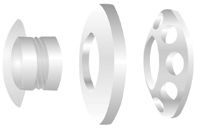Article
Pediatric corneal opacities can be addressed with devices
Author(s):
Las Vegas-Implantation of a keratoprosthesis for pediatric corneal opacity seems to be a promising option for optical rehabilitation. One keratoprosthesis (Boston KPro, Massachusetts Eye and Ear Infirmary) is well tolerated in children and may offer an alternative to penetrating keratoplasty (PKP), which is associated with several potential complications, Matthew D. Gearinger, MD, said at the American Academy of Ophthalmology annual meeting.

PKP performed in children can be a high-risk procedure with the potential for serious complications, making the use of a keratoprosthesis more reasonable.
"Penetrating keratoplasty carries a high risk of allograft rejection, a prolonged period of irregular astigmatism that can lead to refractive amblyopia, trauma, and other unhygienic practices that children engage in more often than adults," explained Dr. Gearinger, assistant professor of ophthalmology, University of Rochester Eye Institute, Rochester, NY.
Two different devices

A retrospective study of the keratoprostheses included 17 children (22 eyes) who ranged in age from 4 weeks to 12 years. All patients had congenital or acquired corneal opacities resulting from Peter's anomaly (13 patients), glaucoma with corneal scarring (six patients), spontaneous perforation (two patients), and sclerocornea (one patient). Twelve eyes had had multiple previous grafts. The mean follow-up after implantation of the keratoprosthesis was about 10 months.
When using the Boston KPro, he explained, an 8-mm central trephination is performed in the host. An 8.75-mm donor corneal button with a 3-mm central aperture is made, and the keratoprosthesis is assembled on the donor tissue and held in place with 16 interrupted sutures. A large bandage contact lens is placed over the top.
When using the Alpha Cor, a partial-depth intralamellar dissection of the cornea is performed with trephination of the posterior lamella. The keratoprosthesis is inserted into the pocket and sutured in place. Three months later, a second procedure is performed to trephinate the anterior cornea.
Children who received the keratoprostheses were assessed for corneal clarity in the visual axis and retention of the devices. Of the 22 eyes, 20 eyes received a Boston KPro and two received an Alpha Cor, one of which was later replaced with a Boston KPro.
"The visual axis was clear in all the eyes that received a Boston keratoprosthesis," Dr. Gearinger reported. "Five eyes developed membranes that were cleared with a YAG capsulotomy in two eyes and with a surgical membranectomy in three eyes. All of the Boston keratoprostheses were retained without extrusion.
"A traumatic extrusion occurred in one patient who received an Alpha Cor, and a penetrating keratoplasty was performed at another institution," he added. "The second patient who received an Alpha Cor had a spontaneous extrusion and then underwent a conversion to the Boston KPro."




